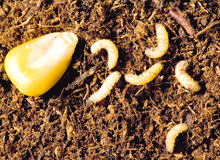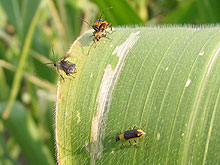Monheim, Gerrmany
July 28, 2008
Source:
Bayer CropScience
|
 |
|
The
main flying time for the western corn rootworm beetle,
and hence the most important period for monitoring, is
July, August and September. |
The Western corn rootworm is
considered one of the world’s most dangerous pests to corn.
Though originally native to South America, the insect is now
spreading at lightning speed across Europe and could soon be
responsible for yield losses of up to 80 percent.
The Western corn rootworm (or Diabrotica virgifera to give it
its scientific name) is five to seven millimeters long and, with
its black and yellow striped wing covers and long antennae,
looks harmless and even almost elegant. Its name, however, is an
initial indication that this beetle is far from harmless. From
early to mid June, the young larvae of the Western corn rootworm
infest the hair roots of young corn seedlings. Later development
stages bore right to the center of the young corn roots. The
consequences for the sensitive plant are clearly apparent; its
long-term supply of water and nutrients is permanently
disrupted. The affected plant remains stunted and its reduced
root mass gives it little resistance to lodging.
In single-crop systems, the yield loss is between ten and, in
particularly severely affected regions, up to 80 percent
|
 |
|
The
larvae, shown here next to a corn kernel to illustrate
their size, tunnel into the roots and destroy them.
|
It is not just the larva, however,
that poses a threat to corn, as the emerging beetle also feeds
predominantly on the plant. It targets mainly the soft silks of
the female flower as well as the milk-ripe cobs and the plants’
leaves. In single-crop systems, the yield loss is between ten
and, in particularly severely affected regions, up to 80
percent.
As a result of the beetle’s affinity for the corn plant, the
spread of the pest has considerable consequences for
agriculture, as very recent history shows. Though originally
native to Central America, the Western corn rootworm spread to
North America as a result of agricultural globalization in the
early 20th century. Nearly 90 years later, the corn rootworm is
continuing its global spread in mainland Europe. The pest was
presumably introduced from America into the former Yugoslavia in
the early 90s with consignments of food for U.S. troops.
The economic toll in the USA is around US$ one billion each
year
Since then, the corn rootworm has gradually spread throughout
Europe. Permanent populations of the corn pest have become
established in Austria, Switzerland and France and the pest has
already emerged in the southern states of Germany. The Ortenau
region of Baden-Württemberg is particularly badly affected.
Experts are sure that the population will spread continuously.
The Western corn rootworm can increase its radius by 40 to 80
kilometers per year through flight or as a result of being
carried on the wind.
The corn rootworm therefore has the status of a quarantine pest
and developments are being monitored by the European
Commission’s Standing Committee on Plant Protection. Few figures
are needed to show the risk potential. By 1997, the corn
rootworm had already infested around 20 million hectares of corn
worldwide. The economic toll in the USA is around US$ one
billion each year. The crucial question from the point of view
of agriculture and downstream production sectors is how can
losses of these dimensions be prevented or at least limited in
Germany and Europe?
 |
|
Corn
seed protected by dressing. A protective zone of
dressing is formed around each seed in the soil.
|
Most long-lasting control with
crop protection agents
In Europe, the corn rootworm has no direct natural enemies, with
the exception of the weather. The adult beetles die as soon as
the first frosts occur and eggs only survive provided that the
temperature does not fall below minus 10 degrees Celsius.
Temperatures this low are already no longer being recorded in
many regions of Germany. A reduction in spread in terms of
lasting control therefore cannot be guaranteed.
One theoretical alternative means of control is crop rotation:
by suspending corn cultivation, the pest’s main food source is
interrupted and its spread is slowed. Experiences in the United
States where the corn rootworm has been prevalent since the
1960s have shown that this approach cannot guarantee long-term
success, however. The pathogen has developed numerous
resistances to this measure, including one-year egg dormancy.
This means that the larvae halt their development for a year
without food, in other words when another plant is being grown
as a result of crop rotation. In the following year, when corn
is being grown again, the larvae hatch again as before.
It must also be kept in mind that the corn rootworm is the
tourist of the insect pests. It generally spreads along transit
and transport routes such as airports, rivers and motorways.
Regular reinfestion from the main areas of infestion in southern
Europe each year is therefore not just possible but certain.
Longest-lasting control is achieved with crop protection agents.
Effective insecticides can either be sprayed onto the leaves of
the corn plant or delivered with spot precision and highly
effectively into the soil through seed dressing. The solution
can therefore only lie in balanced control. Use of dressed seeds
is probably the most ecofriendly way of using crop protection
agents.
|
The
western corn rootworm |
 |
|
Heavy
infestation with the western corn rootworm
can destroy up to 80 percent of the corn
harvest. |
The western corn
rootworm (Diabrotica virgifera) originates from
Central America, the botanical home of the corn
plant. It migrated to the United States several
decades ago, where it causes damage worth a billion
dollars every year. The rootworm beetles can
increase their radius by between 40 and 80
kilometers every year either actively or by being
carried on the wind.
The pest
The rootworm beetle is about 5 – 7 mm long and has a
dark head, a yellow plate on the back of its thorax
and yellow and black-striped wing covers. The thin,
elongated larvae have three pairs of legs, a
whitish-brown head and a brown plate of chitin at
the end of their abdomen; they are about 10 – 18 mm
long. The first larvae generally appear in May and
June. The larvae develop through three stages over a
period of 3 – 4 weeks. Pupation lasts only a few
days. After she has mated in the summer, the female
lays up to a thousand eggs in the soil around the
roots of the corn plant. The adult rootworm beetles
only survive until the first frost. The larvae hatch
the following spring as long as the temperature does
not go below minus 10 degrees Celsius.
Damage
The rootworms eat mainly pollen, corn silk and
sometimes milk-bearing kernels. Their feeding
activity impairs fertilization and thus the
development of the kernels. They start feeding on
the leaves (producing a window-pane pattern) as soon
as the corn buds appear.
The larvae cause far more damage than the adult
rootworm beetles. The young larvae first eat the
hair roots; later instars eat the larger roots. They
tunnel into the roots and eat all the root tissue,
thus impairing water uptake and the transport of
nutrients to the parts of the plant above ground.
This predisposes the plants to secondary infections
and causes the stems to lean severely to one side, a
phenomenon known as lodging. |
|
|